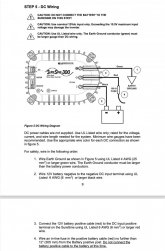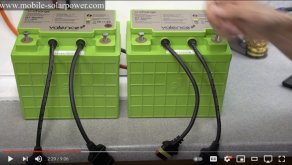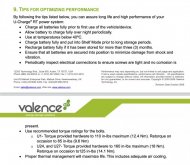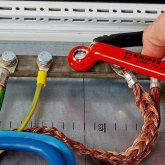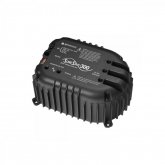reg
Winter: New York City Summer: Atlantic Canada
- Joined
- Mar 24, 2021
- Messages
- 336
I plan to set up my summer home for solar power, but my first project is to get a lithium battery to supply me with 12V DC and AC electricity. I thought that I'd start this thread as a way to document that. Perhaps over time others will find the thread useful. Some people may be interested in the thread just to see the test results for the Lithium Werks Valence battery that I expect to receive this week.
Historically, I've used AGM (Absorbent Glass Mat) batteries to start cars, motorbikes and boats, and to run related, low draw accessories such as lights, and of course I use small lithium-ion batteries to run portable devices such as my mobile phone, tablet computer and digital cameras. This is my first foray into setting up a battery that will deliver electricity to a wide variety of devices, regardless of whether they require DC or AC to run.
I'll be using the following components (photos below), and I'll post about putting them together over the next week or so.
12V Battery (Lithium Iron Magnesium Phosphate)
Maker: Lithium Werks
Model: Valence U-Charge, RT Series, U1-12RT (In December 2020, Lithion Battery purchased Lithium Werks's Valence battery business.)
Specifications: 12.8V 40Ah (512Wh)
Weight: 6.5kg (14.4lbs)
Price: US$180 + $13 shipping from jobber Battery Hookup in Pennsylvania
I was on the verge of purchasing a Battle Born 50Ah battery or RELiON 35Ah battery when a participant in this forum told me that Battery Hookup has some of Lithium Werks's Valence 40Ah batteries for sale at attractive prices. There's discussion about the various brands and models of battery that I considered in the thread Need Recommendations for an Off-the-Shelf 25Ah to 50Ah LiFePO4 Battery. The details of the Battery Hookup offer are in this post near the end of the thread.
I decided to purchase one of Battery Hookup's Lithium Werks batteries. Battery Hookup is less than 160km (100mi) from me, so I expect to receive the battery this week. It is supposed to be at 100% capacity and probably unused, but I'll have to confirm capacity by testing. If the description proves correct, a member of this forum will have saved me a substantial amount of money.
Will Prowse has made at least three videos that talk about Lithium Werks's Valence batteries, including a teardown video of the U-Charge RT model that I've purchased. The 2019 Lithium Werks video below describes the U-Charge series. Note that the RT battery is unique in the series in that it has an integrated Battery Management System.
Charger for 12V Battery
Maker: Victron Energy
Model: Blue Smart IP65 10A
Bluetooth App: Victron Connect (iOS and Android)
Weight: 0.9kg (2lbs)
Price: US$128, shipping included, from Bluewater Boat Supply in North Carolina (also available from Amazon U.S.)
I purchased this charger after concluding that my Yuasa 1A motorbike charger (I prefer to slow-charge my bike battery) isn't going to cut it when it comes to charging the Valence battery.
This 2016 Victron video explains the Blue Smart IP65 charger and the Victron Connect app:
This 2019 video discusses updates to the app:
Inverter for 12V Battery
Maker: Morningstar Corporation
Model: SureSine
Waveform: Pure Sine Wave
Continuous Power: 300W
Peak Power: 600W
Weight: 4.5kg (10lbs)
Price: US$280, shipping included, from Stellavolta in Texas (also available from Amazon U.S.)
This inverter is unusually heavy for its dimensions and output because it dissipates heat via a heat sink rather than by a fan. Hence the fins on the case (see photo below). I wanted fanless because I intend to use the inverter while recording sound. Microphones and fan noise don't mix.
Also, this inverter does not have an integrated AC outlet. I'll have to add one.
This March 1, 2021 "unboxing" video appears to be the only video in English that provides an overview of the SureSine inverter. On March 23, the same fellow uploaded a video that shows and discusses the SureSine's internal electrical components.
Photos:
Lithium Werks Valence U1-12RT Battery
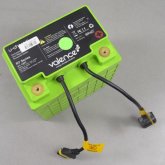
Victron Energy IP65 Charger
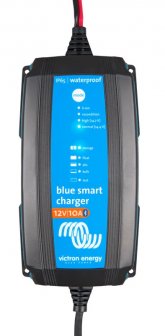
Morningstar SureSine 300W Inverter

Historically, I've used AGM (Absorbent Glass Mat) batteries to start cars, motorbikes and boats, and to run related, low draw accessories such as lights, and of course I use small lithium-ion batteries to run portable devices such as my mobile phone, tablet computer and digital cameras. This is my first foray into setting up a battery that will deliver electricity to a wide variety of devices, regardless of whether they require DC or AC to run.
I'll be using the following components (photos below), and I'll post about putting them together over the next week or so.
12V Battery (Lithium Iron Magnesium Phosphate)
Maker: Lithium Werks
Model: Valence U-Charge, RT Series, U1-12RT (In December 2020, Lithion Battery purchased Lithium Werks's Valence battery business.)
Specifications: 12.8V 40Ah (512Wh)
Weight: 6.5kg (14.4lbs)
Price: US$180 + $13 shipping from jobber Battery Hookup in Pennsylvania
I was on the verge of purchasing a Battle Born 50Ah battery or RELiON 35Ah battery when a participant in this forum told me that Battery Hookup has some of Lithium Werks's Valence 40Ah batteries for sale at attractive prices. There's discussion about the various brands and models of battery that I considered in the thread Need Recommendations for an Off-the-Shelf 25Ah to 50Ah LiFePO4 Battery. The details of the Battery Hookup offer are in this post near the end of the thread.
I decided to purchase one of Battery Hookup's Lithium Werks batteries. Battery Hookup is less than 160km (100mi) from me, so I expect to receive the battery this week. It is supposed to be at 100% capacity and probably unused, but I'll have to confirm capacity by testing. If the description proves correct, a member of this forum will have saved me a substantial amount of money.
Will Prowse has made at least three videos that talk about Lithium Werks's Valence batteries, including a teardown video of the U-Charge RT model that I've purchased. The 2019 Lithium Werks video below describes the U-Charge series. Note that the RT battery is unique in the series in that it has an integrated Battery Management System.
Charger for 12V Battery
Maker: Victron Energy
Model: Blue Smart IP65 10A
Bluetooth App: Victron Connect (iOS and Android)
Weight: 0.9kg (2lbs)
Price: US$128, shipping included, from Bluewater Boat Supply in North Carolina (also available from Amazon U.S.)
I purchased this charger after concluding that my Yuasa 1A motorbike charger (I prefer to slow-charge my bike battery) isn't going to cut it when it comes to charging the Valence battery.
This 2016 Victron video explains the Blue Smart IP65 charger and the Victron Connect app:
This 2019 video discusses updates to the app:
Inverter for 12V Battery
Maker: Morningstar Corporation
Model: SureSine
Waveform: Pure Sine Wave
Continuous Power: 300W
Peak Power: 600W
Weight: 4.5kg (10lbs)
Price: US$280, shipping included, from Stellavolta in Texas (also available from Amazon U.S.)
This inverter is unusually heavy for its dimensions and output because it dissipates heat via a heat sink rather than by a fan. Hence the fins on the case (see photo below). I wanted fanless because I intend to use the inverter while recording sound. Microphones and fan noise don't mix.
Also, this inverter does not have an integrated AC outlet. I'll have to add one.
This March 1, 2021 "unboxing" video appears to be the only video in English that provides an overview of the SureSine inverter. On March 23, the same fellow uploaded a video that shows and discusses the SureSine's internal electrical components.
Photos:
Lithium Werks Valence U1-12RT Battery

Victron Energy IP65 Charger

Morningstar SureSine 300W Inverter

Last edited:




